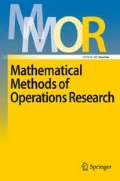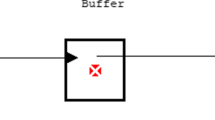Abstract
We study the problem of using information about the type of machine failures to control production. When each station in a two stage flowline has a single machine, the processing time distributions are Erlang, and the time to fail as well repair a machine are exponentially distributed; we show that the optimal policy for controlling the flowline is completely specified by selecting a produce up to level called threshold level corresponding to each type of machine failure. These threshold levels are shown to be ordered as per the rate at which the failed downstream station can be repaired. These results are partially extended to the case when there are multiple machines at the two stations of the flowline. We then summarize numerical results that illustrate when it is worth while to use information about failures in controlling inputs to the flowline.
Similar content being viewed by others
References
Akella A, Kumar PR (1986) Optimal control of production rate in a failure prone manufacturing system. IEEE Trans. Automatic Control 31:116–126
Birge JR, Glazebrook KD (1988) Assessing the effects of machine breakdowns in stochastic scheduling. OR Letters 7, 6:267–271
Boukas E, Haurie A (1990) Manufacturing flow control and preventive maintenance: A stochastic control approach. IEEE Trans. Automatic Control 36, 5:1024–1031
Buzacott JA, Shanthikumar JG (1992) PAC: A general approach for coordinating production in multiple-cell manufacturing systems. Prod. Oper. Manag.: 34–52
Buzacott JA, Shanthikumar JG (1993) Stochastic models of manufacturing systems. Prentice-Hall, New York
Gershwin SB (1988) Hierarchical flow control: A framework for scheduling and planning discrete events in manufacturing systems. IEEE Proc. Special Issue on Discrete Event Systems
Glassey CR, Seshadri S, Shanthikumar JG (1996) Linear control rules for production control of semiconductor fabs. IEEE Trans. Semiconductor Manufacturing 9, 4:536–549
Glassey CR, Seshadri S, Shanthikumar JG (1996a) Using information about machine failures to control flowlines. Working Paper. Department of Statistics & Operations Research, New York University
Glazebrook KD (1987) Evaluating the effect of machine breakdowns in stochastic scheduling problems. Naval Research Logistics 34, 3:319–335
Gershwin SB (1994) Manufacturing systems engineering. Prentice Hall, NJ
Harrison JM (1988) Brownian models of queueing networks with heterogeneous customer populations. In: Fleming W, Lions PL (eds) Stochastic differential systems, stochastic control theory and applications, IMA Volume 10, Springer-Verlag, Berlin: 147–186
Harrison JM, Wein LM (1990) Scheduling networks of queues: Heavy traffic analysis of a twostation closed network. Operations Research 38, 6:1052–1064
Hildebrandt RR (1980) Scheduling machining systems when machines are prone to failures. Ph.D. Thesis, MIT, Dept. of Astronautics and Aeronautics
Kumar PR (1993) Re-entrant lines. Queueing Systems 13:87–110
Kumar PR (1994) Scheduling semiconductor manufacturing plants. IEEE Control Systems: 33–40
Kushner HJ (1990) Numerical methods for stochastic control problems in continuous time. SIAM J. Control and Optimization 28, 5:999–1048
Lippman SA (1975) Applying a new device in the optimization of exponential queuing systems. Operations Research 23, 4:687–710
Nurani RK (1995) Role of in-line process monitoring and control in wafer fab management. Ph.D. Dissertation, GSIA, Carnegie Mellon University, Pittsburgh, PA 15213
Nurani RK, Seshadri S, Shanthikumar JG (1995) Optimal control of a single stage production system subject to random process shifts. To appear in Operations Research
Pinedo M, Ramouz E (1988) A note on stochastic scheduling on a single machine subject to breakdown and repair. Prob. Eng. Inform. Sciences 2:41–49
Pinedo M (1995) Scheduling: Theory, algorithms and systems, Prentice Hall, NJ
Posner MJM, Berg M (1988) Analysis of a production-inventory system with unreliable production facility. Operations Research Letters 8:339–345
Ross SM (1970) Applied probability models with optimization applications. Holden-Day, San Francisco
Seshadri S (1993) Stochastic models of semiconductor fabs. Ph.D. Thesis, Haas School of Business Administration, University of California, Berkeley, CA 94720
Seshadri S, Shanthikumar JG (1994) Allocation of chips to wafers in a production problem of semiconductor chips. To appear in Operations Research
Sharifnia A (1988) Production control of a manufacturing system with multiple machine states. IEEE Trans. AC 33, 7:620–625
Thomas LJ (1993) Stockless and fast production: Review and research agenda. In: Sarin RK (ed.), Perspectives in operations management: Essays in honor of Elwood S. Buffa, Kluwer Academic Publishers, Boston, MA
Uzsoy R, Lee CY, Martin-Vega LA (1992) A review of production planning and scheduling models in the semiconductor industry. 1. System Characteristics, Performance Evaluation and Production Planning. HE Trans. 24, 4:47–60
Uzsoy R, Lee C, Martin-Vega LA (1994) A review of production planning and scheduling models in the semiconductor industry, Part II: Shop-floor control. HE Transactions 26:44–55
Veatch MH, Wein LM (1993) Optimal control of a two-station tandem production/inventory system. Manuscript, Operations Research Center and Sloan School of Management, M.I.T.
Wein LM (1990) Optimal control of a two-station Brownian network, Math. Operations Research 15, 2:215–242
Author information
Authors and Affiliations
Additional information
The work of C. Roger Glassey and Sridhar Seshadri was partly supported by grants to the University of California from the Semiconductor Research Corporation and the California State MICRO program.
The work of J. G. Shanthikumar was partly supported by NSF Grant DDM-9113008 and the Sloan Foundation grants for the study on “Competitive Semiconductor Manufacturing.”
Rights and permissions
About this article
Cite this article
Roger Glassey, C., Seshadri, S. & Shanthikumar, J.G. Using information about machine failures to control flowlines. Mathematical Methods of Operations Research 45, 455–481 (1997). https://doi.org/10.1007/BF01194790
Issue Date:
DOI: https://doi.org/10.1007/BF01194790




